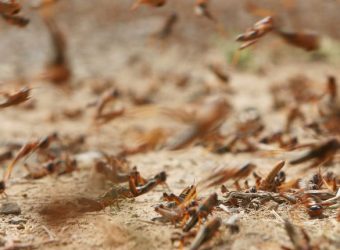Thematic overview
Agricultural development is a condition sine qua non, to end poverty in Developing Countries. Growth in the agriculture sector is very effective to raise incomes among the poorest. However, due to amongst other factors climate change, agricultural growth is at risk. Agricultural production has unique characteristics that differ from other forms of production, several random phenomena, with high degree of spatial and temporal variability, especially climate, may adversely affect crop and cattle production. Agricultural production is at the forefront of climate change and population growth impacts as the ecosystems on which it relies are increasingly degraded and the availability of suitable land for food production is declining. To help combat the threatening pressures of climate change there is an urgent need for accurate and consistent information for well-informed risks assessment and decision making and governance at multiple levels.
Earth Observation (EO) technology has become a regular tool in the large-scale agricultural production systems of industrialised and emergent countries. The ‘Agriculture’ project in the GDA programme aims the delivery of EO services to support IFIs and their Client States in addressing the recurrent challenges they face in risk assessment and monitoring, medium- and long-term planning, food production monitoring and forecasting and assessment of development priorities as well as support mitigation actions in the agricultural sector.
Agriculture Themes
Carbon farming
Carbon Farming is a whole farm approach to optimising carbon capture on working landscapes by implementing practices that are known to improve the rate at which CO2 is removed from the atmosphere and stored in plant material and/or soil organic matter. Carbon farming techniques include cover crops, crop diversification – rotation, optimised tillage or fertiliser management to name a few. New technologies and the unprecedented availability of satellite data are causing a paradigm shift in the way carbon farming may be monitored, valued and marketed.
Reduction of rice methane emission
Rice is estimated to be responsible for about 16% of agricultural greenhouse gas emissions by releasing methane caused by long-term flooding of rice fields which leads to anaerobic fermentation of organic matter in the soil. Getting reliable information on rice growing areas and rice farming practices is crucial to minimise the amount of CH4 produced from rice cultivation. While providing this information EO can improve the efficiency and effectiveness of projects and policy because it allows decision makers to concentrate efforts in regions with the greatest potential GHG reductions and the capabilities relevant for Monitoring Reporting and Verification (MRV) schemes of CH4 emissions from rice paddy cultivation.
Irrigation management performance
The agricultural sector is by far the largest user of water in the world. On a consumptive use basis, 80–90% of all the water is consumed in agriculture. Unfortunately, water use efficiency in this sector is very poor not exceeding 45% with more than 50% water losses; thereby, enormous water saving could be achieved in the agricultural sector comparable with other sectoral water uses. At the same time drought is the major disaster affecting food production, alone drought accounts for almost 40% of the crop and livestock losses by disasters in the last decades. Irrigation is the most efficient manner to combat drought but water is a sparse and finite resource. EO provides input for the assessment, monitoring and optimisation of agricultural water use. EO can support the enhancement of water management practices to ensure the highest yield per water drop.
Resilient and sustainable agricultural production
To minimise the human impact on the Earth’s natural resources and avoid land use triggered conflicts, it is extremely important that we focus on increasing agricultural productivity in a sustainable manner, from large scale agriculture to small-holders farming. Earth Observation is a powerful technique for continuously assessing the status of agricultural production on a wide range of spatial and temporal scales. We will provide historical to current local to national data on cultivated areas (crop type, acreage, irrigation supply) and yield assessment.
Food Security financing
Food security remains an urgent issue, and is even further enhanced through the COVID-19 pandemic constraints. The planning and prioritisation of development cooperation investments often require geospatial information on agricultural, socio-economic as well as climate change aspects at national to global scale, which partly can be provided by satellite EO. Furthermore, the monitoring and evaluation of impact related to these investments are an essential part of Food Security programs. We will customise and integrate existing or new EO information layers for informing Food Security programs.
Food system value chains
Sustainable value chains are a multifaceted issue, including aspects ranging from soil protection, reduced tillage, the application of integrated pest management, to the integration of livestock, crops and agroforestry practices. Agriculture-driven deforestation and forest degradation is one major concern in tropical countries. Growing public concern about the contribution of forest loss to climate change and biodiversity decline has spurred new initiatives by private sector actors to increasingly scrutinise their supply chains and operations. These efforts include the adoption of aspirational goals by single companies or coalitions of actors, corporate codes of con-duct and sustainability standards that, in some cases, are implemented through certification schemes and moratoria. This use case aims to the implementation of EO services to support MRV and assessment of implementation of commitments.
Locust monitoring
The recent massive desert locust upsurge in Eastern Africa and Southwest Asia, caused by favourable climatic conditions, highlighted the need for constant monitoring of the locust situation, related environmental conditions, and to provide forecasts for managing prevention measures. Satellite capabilities can significantly improve the timeliness and accuracy of locust outbreak forecasting. Early warning means countries can act swiftly to control a potential outbreak and prevent massive food losses. Similar EO approaches could be considered for further pests (e.g. fall armyworm) affecting severely agricultural production.
Agro-Climatic Resilience
As the climate continues to change, seasonal redistribution of rainfall and rising temperatures will put increasingly direct pressure on food production. Agriculture and pastoralism are at the frontline of the impact of climate change. They are the basis of food security in developing countries and deviations from nominal weather patterns and the impacts of such deviations have to the environment can threaten human life. In response to recognised challenges associated with land degradation and ecosystem health due to non-resilient agriculture practices, EO data are key for assessing the problems and exposure to future risks for ecosystems and agricultural land by identifying health condition and informing on prioritise sites for restoration opportunities.
Sustainable livestock farming
“Balanced diets based on sustainably produced plant and animal foods, i.e. systems that generate low greenhouse gas [GHG] emissions, offer greater opportunities to adapt to climate change and limit its effects,” says the United Nations Intergovernmental Panel on Climate Change (IPCC). In its latest report, the IPCC directly advocates sustainable livestock farming as part of the solution to curb the climate crisis. The integration of EO services within the decision-making processes of commercial livestock farmers would allow attain higher efficiencies while saving production inputs. Better knowledge about pasture quality and production would allow selection of pasture species naturally adapted to climate changing conditions or inform the adoption , design and assessment of climate smart cattle ranching practices.
Discover our
e-flyer and
brochure for more information regarding services and products provided on these themes in response to requirements identified in the Agriculture domain by IFIs and their Client Countries:


Supported IFIs projects
Consortium Members































